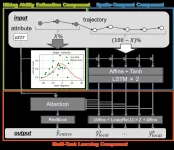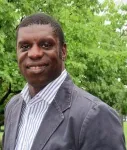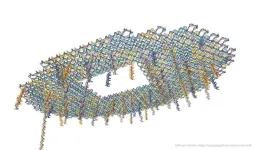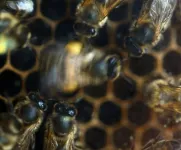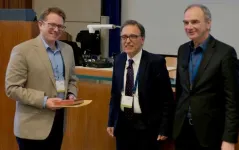(Press-News.org) At the University of Electro-Communications, a research team led by Mizuho Asako, Yasuyuki Tahara, Akihiko Ohsuga, and Yuichi Sei has developed a new deep learning model called "HikingTTE" that significantly improves hiking travel time estimation. Hiking is popular worldwide, but accidents still occur when hikers underestimate the time needed to reach their destination.
This model could help reduce mountain accidents and improve hiker safety by providing more accurate travel time predictions. Previous hiking travel time estimation methods often use the relationship between slope (uphill or downhill) and walking speed. However, these methods do not fully take into account individual walking ability or how fatigue builds up over long distances. HikingTTE addresses these issues by combining a modified Lorentz function-based slope-speed function with a deep learning framework that includes LSTM (Long Short-Term Memory) and attention modules. LSTM is well suited for handling time-series data, while the attention mechanism highlights important parts of the GPS data for more accurate predictions.
A key strength of HikingTTE is its ability to learn a hiker’s walking ability from only part of the GPS data recorded during the trip. By analyzing the performance in the first part of the route, the model creates a slope-speed function for that person and then applies it to estimate the remaining travel time. Additionally, by using LSTM and an attention-based mechanism, HikingTTE accounts for changes in terrain and the effects of fatigue, leading to more reliable estimates than existing models.
In experiments, HikingTTE outperformed conventional hiking travel time estimation techniques, reducing the Mean Absolute Percentage Error (MAPE) by 12.95 percentage points. It also outperformed other deep learning models originally designed for transportation tasks by 0.97 percentage points. The research team believes that these results could set a new standard for hiking travel time estimation.
In the future, the team plans to include each hiker's past logs to further personalize the predictions. By helping hikers plan and adjust their pace more effectively, this innovation is expected to prevent delays, minimize risks, and ultimately save lives on the trail. The model could also be integrated into hiking apps or navigation tools, providing practical and reliable guidance.
Authors:
Mizuho Asako (Main)
-- The University of Electro-Communications, Master student
Yasuyuki Tahara
-- The University of Electro-Communications, Associate Professor
Akihiko Ohsuga
-- The University of Electro-Communications, Professor
Yuichi Sei
-- The University of Electro-Communications, Professor
END
HikingTTE: a deep learning approach for hiking travel time estimation based on personal walking ability
2025-02-25
ELSE PRESS RELEASES FROM THIS DATE:
Environment nudges birds to fast, or slow, life lane
2025-02-25
Birds worldwide make strategic decisions about how they live based on their environmental conditions. Some live fast, die young, and leave as many chicks as possible. Others live long and prosper by not breeding.
A new study of non-migratory birds provides clues about how climate change may affect the long-standing evolutionary strategies of feathered friends. The work is reported in this week’s Ecology Letters and was led by Michigan State University postdoctoral fellows of the MSU Institute for Biodiversity, Ecology, Evolution, and Macrosystems (IBEEM).
The ...
The U-shaped relationship between admission peripheral oxygen saturation and all-cause hospital mortality in acute exacerbation of chronic obstructive pulmonary disease: a retrospective analysis using
2025-02-25
Highlight box
Key findings
• This study investigated the U-shaped nonlinear relationship between admission oxygen saturation (SpO2) and all-cause hospital mortality in patients with acute exacerbation of chronic obstructive pulmonary disease (AECOPD). The results showed that the lowest all-cause hospital mortality was observed at an SpO2 of 89.5%. Additionally, SpO2 was identified as an independent risk factor for predicting all-cause hospital mortality in AECOPD patients, providing valuable guidance for optimizing oxygen therapy in this population.
What is known and what is new?
• Most studies indicate that maintaining SpO2 levels between 88–92% provides ...
New research highlights wide variation in prostate cancer testing between GP practices
2025-02-25
A largescale study has found huge variation between GP practices on whether they are likely to pick up prostate cancer using a blood test.
The University of Exeter led a study which aimed to investigate the proportion of patients whose prostate cancer was identified by using a prostate-specific antigen (PSA) test when patients had no symptoms.
The research published in the British Journal of General Practice and funded by Cancer Research UK, and, has found that one in five patients with prostate cancer in England are diagnosed after PSA testing when they had no symptoms – fewer than previously thought. The PSA test ...
Antidepressants linked to faster cognitive decline in dementia
2025-02-25
New research suggests that antidepressants can accelerate cognitive decline in people with dementia. At the same time, some drugs appear to be less harmful than others, which can help doctors make better treatment decisions, according to the study published in BMC Medicine.
Antidepressants are often used to relieve symptoms such as anxiety, depression, aggressiveness, and sleep disturbances in dementia sufferers.
However, a new observational study based on data from the Swedish Dementia Registry (SveDem) shows that patients with dementia who are treated with antidepressants experience an increased cognitive decline compared to patients who do not ...
DNA origami suggests route to reusable, multifunctional biosensors
2025-02-25
Using an approach called DNA origami, scientists at Caltech have developed a technique that could lead to cheaper, reusable biomarker sensors for quickly detecting proteins in bodily fluids, eliminating the need to send samples out to lab centers for testing.
"Our work provides a proof-of-concept showing a path to a single-step method that could be used to identify and measure nucleic acids and proteins," says Paul Rothemund (BS '94), a visiting associate at Caltech in computing and mathematical sciences, and computation and neural systems.
A paper describing the work recently appeared in the journal Proceedings of the National Academy of Sciences. The lead authors of ...
Virginia Tech study reveals that honeybee dance ‘styles’ sway food foraging success
2025-02-25
As far as animals go, honeybees are world-class dancers.
While not as deep and complex as a Super Bowl half-time show, the bees' moves, known as the “waggle" dance, convey very specific food foraging instructions to their nestmates. The direction the dancer moves explains to other bees which way to go, and the duration of the waggle dance, or the “run,” shows how far to go. Once other bees have been convinced to follow the directions, they are “recruited.” After receiving the instructions, these ...
Beehive sensors offer hope in saving honeybee colonies
2025-02-25
A UC Riverside computer science team has developed a sensor-based technology that could revolutionize commercial beekeeping by reducing colony losses and lowering labor costs.
Called the Electronic Bee-Veterinarian, or EBV, the technology uses low-cost heat sensors and forecasting models to predict when hive temperatures may reach dangerous levels. The system provides remote beekeepers with early warnings, allowing them to take preventive action before their colonies collapse during extreme hot or cold weather or when the bees cannot regulate their hive temperature because of disease, pesticide exposure, food shortages, or other stressors. ...
Award-winning research may unlock universe’s origins
2025-02-25
University of Texas at Arlington physicist Ben Jones has received an international honor for his contributions to developing advanced instruments used in particle physics research.
Dr. Jones, an associate professor of physics, was awarded the 2025 International Committee for Future Accelerators (ICFA) Early Career Researcher Instrumentation Award. Presented by the ICFA Instrumentation Innovation and Development Panel, the award recognizes significant advancements in the innovation and development of new instrumentation for future accelerator experiments.
He accepted the award last week at the 2025 Vienna ...
BRCA1 gene mutations may not be key to prostate cancer initiation, as previously thought
2025-02-25
Mutations in the BRCA1 gene that are either inherited (germline) or acquired (somatic) might not be key to the initiation of prostate cancer, as previously thought, suggests the first study of its kind, published online in the open access journal BMJ Oncology.
If confirmed in further studies, the findings suggest that it may be time to reassess current treatment with PARP (poly(ADP-ribose) polymerase) inhibitor drugs, which block the ability of cells, including cancer cells, to repair DNA damage, in men with BRCA1 genetic variants, say the researchers.
A linked editorial suggests that the findings pave the way for greater refinement of genetic ...
Melatonin supplementation may help offset DNA damage linked to night shift work
2025-02-25
Melatonin supplementation may help offset the DNA damage associated with night shift work by boosting the body’s ability to repair it, suggest the findings of a small clinical trial published online in the journal Occupational & Environmental Medicine.
Larger studies looking at varying doses and the potential long term effects of melatonin supplementation are now warranted, conclude the researchers.
Normal night-time production of the body clock hormone, melatonin, is suppressed in night shift workers. This compromises the body’s ability to repair oxidative DNA damage, the by-product of normal cellular processes, heightening the risk of ...
